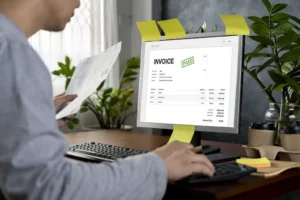Businesses have multiple ways to borrow money. Some companies receive goods or services on credit, promising to pay the invoice within 30–60 days. Others take out loans from banks or financial institutions, repaying the principal plus interest over time. While both approaches mean financial obligations, accounting categorizes them differently. The first scenario falls under accounts payable (AP), whereas the latter is classified as notes payable (NP). Let’s explore the key distinctions between notes payable vs accounts payable and discover how to manage them more efficiently.
Accounts Payable Explained
Before we discuss AP vs NP, it’s important to understand each term. Actually, accounts payable are money a firm owes to suppliers, generally within 30, 60, or 90 days or another agreed-upon period. These debts arise because the firm gets products or services on credit and are recorded as liabilities on the balance sheet.
Companies frequently buy things from the same suppliers, making formal contracts less common compared to bank loans. Instead, accounts payable serves as a reminder for financial professionals to settle outstanding invoices. Here are some common examples:
- Purchase of modern equipment or furniture;
- Purchase of consumables;
- Consulting services;
- Utilities related to office activities.
At the beginning of its work, a business can ask an accountant to work with AP, but as the company grows, it will need to automate procedures or hire several specialists to work with suppliers. These financial professionals must know all the ins and outs of notes payable vs accounts payable.
How does Accounts Payable Affect a Firm?
Effective management of AP is critical for the prosperity of your venture. Let’s consider the role AP plays in the firm activity:
- Sustained operations: AP allows an organization to buy resources, materials, and services without paying for them immediately. Companies can use trade credit to maintain money flow and ensure routine daily activity.
- Positive relationships with counterparties. If a business makes timely payments, it improves its relationships with counterparties. As a result, it can receive more beneficial credit conditions and discounts for prompt payment.
- Stable cash flow. A business must balance payments and incoming finances to avoid a reduction in liquidity and ensure that responsibilities are met without sacrificing development. This guarantees the company’s stable operation and creates development prospects.
If a company controls AP, it decreases the risks of late payments, including fines, problems with counterparties, and work stoppages. Firms can also prevent mistakes related to overpayment.
Notes Payable Explained
In short, notes payable is money a firm owes to financial establishments and other creditors. Being a part of general ledger accounting, it is a formal commitment to repay a specified amount within an agreed timeframe. Suppose a firm has no finances but wants to make an expensive purchase, it issues a promissory note to a bank or other financial establishment to loan the money it needs to make the deal.
When a firm enters into a promissory note agreement, it ensures that the sum owed will be repaid. The borrower also adds principal and interest to the note until the debt is repaid in full.
NP contains all the notes a firm has issued to partners or creditors. The interest that must be paid on the NP may be excluded from the tax liability for the year, decreasing the cost of raising finances.
How does Notes Payable Affect Business?
NP is critical to a business’s long-term financial health. It is associated with significant sums and interest, meaning its constant monitoring is critical for future scaling.
- The ability to receive money to adopt large-scale projects. NP is a profitable solution for firms implementing ambitious programs, including purchasing modern machines, increasing production volumes, or opening new divisions.
- Predictable debt management. NP offers clear payment schedules and interest rates, allowing organizations to service their debt with a high degree of predictability. This allows the firm to avoid significant burdens by spreading expenditures throughout the month.
- Strong creditworthiness. A business that meets all NP obligations creates a positive credit history. This may lead to better terms in the future, including favorable interest rates, increased credit limits, and quick access to finances.
NP agreements often include clauses that allow firms to change payment schedules when a major event occurs. Such concessions allow firms to prevent default and stay afloat during stagnation.
Key Distinctions Between Accounts Payable and Notes Payable
Both AP and NP are related to debt management. When we create a balance sheet, they appear in the obligations section. As a firm pays off arrears, such elements are debited from obligations and credited as cash or other assets. Both types of commitments include payment conditions so companies know when to finish a transaction. The table summarizes the critical distinctions when we speak about notes payable vs accounts payable.
| Criterion | AP | NP |
| Category of obligation | The firm gets materials and resources from the counterparty and must pay for them in accordance with the conditions specified in the invoice. | The organization receives money from financial establishments or other counterparties and must return it according to the terms of the official agreement. |
| Formality and legal status | Less formal, as suppliers provide goods or services with the expectation of payment based on the invoice terms. No additional agreements are required. | More formal, involving legally binding agreements that specify interest rates, repayment schedules, and, if applicable, collateral requirements. |
| Interest and additional costs | If the recipient meets payment deadlines, no interest is required. Some suppliers even offer discounts for early payments, helping businesses reduce costs. | It always contains expenditures reflected in financial reports, primarily in the profit and loss statement. |
| Payment terms | All payments must be made during 1 year or earlier. | Short-term liabilities must be paid off during the year, and long-term notes payable (LTNP) are calculated for longer periods. |
| Security and risks | Do not require collateral. Late transactions may worsen the business’s creditworthiness and negatively impact partner cooperation. | Often require collateral in the form of assets or obligations. If the borrower fails to repay on time, the lender has the right to seize the pledged collateral. |
| Financial statements | They are shown in the current obligations line because they are relevant in the limited period. | It may be written as current obligations if the return time does not exceed 12 months or as long-term obligations if the return time is longer. |
Realizing the main elements of accounts payable vs notes payable allows finance professionals to prioritize payments, keeping the business moving forward. Firms can operate more smoothly by understanding their short-term and long-term working capital and maintaining accurate records of their debts.
Managing Accounts Payable and Notes Payable Efficiently
Businesses must understand the primary aspects of notes payable vs accounts payable to maintain liquidity and establish long-term partner cooperation. Let’s discuss how to handle liabilities effectively.
- Understand your cash flow. Knowing when funds come into and out of the account is important. Perhaps the firm has outstanding accounts receivable and finances will arrive in the coming days, this will not help to pay all obligations at the moment. Think about changing the sales algorithm and operational activities so as not to experience constant stress due to the need to pay off debts.
- Use specific software. Procure-to-pay (P2P) solutions allow you to monitor expenditures and form a value proposition for the next cooperation. An advanced P2P process provides complete visibility to cut expenditures and enhance the logistics network to prevent manufacturing stoppages. NP apps control repayment schedules, estimate interest, and remind you to pay in the coming days.
- Create a comprehensive budget. This document outlines how to allocate your savings to achieve your financial goals. An essential step in the budgeting process is creating an algorithm for how you will make payments on obligations. When creating a budget, estimate future debt payments. During the budgeting process, you will find methods of cutting expenses to ensure that there is money to manage liabilities.
- Value your counterparties. Your suppliers also have businesses that go through ups and downs. Make early payments whenever possible and always report financial force majeure to build trust with them. Your good faith will help you gain more freedom regarding payment for materials in the next interaction.
Whether interacting with notes payable vs accounts payable, monthly reconciliations are recommended to define discrepancies, provide compliance with financial standards, and prevent duplicate transactions or missed operations.
Conclusion
In this blog post, we have looked into notes payable vs accounts payable. AP represents the money a firm owes to vendors for materials and items received for its regular operations. These are short-term liabilities governed solely by the terms of the invoice, without a formal contract. NP, on the other hand, is governed by a formal agreement in which the borrower commits to return a specified amount by a set date. Such obligations typically involve larger sums, interest payments, and a structured repayment schedule.
If you decide to explore accounts vs notes payable in more detail, we recommend contacting BooksTime specialists. A qualified team will help with AP and NP processing, tell you how to implement automation elements and strengthen the trust of suppliers and financial institutions.


















